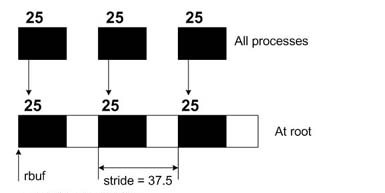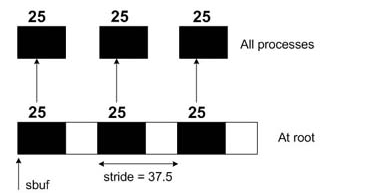Gatherv and Scatterv
MPI_Gatherv and MPI_Scatterv are the variable-message-size versions of MPI_Gather and MPI_Scatter. MPI_Gatherv extends the functionality of MPI_Gather to permit a varying count of data from each process and to allow some flexibility in where the gathered data is placed on the root process. It does this by changing the count argument from a single integer to an integer array and providing a new argument displs (an array). MPI_Scatterv extends MPI_Scatter in a similar manner. More information on the use of these routines will be presented in an Application Example later in this roadmap.
Gatherv and Scatterv Syntax
int MPI_Gatherv(void *sbuf, int scount, \
MPI_Datatype stype, void *rbuf, int *rcounts, \
int *displs, MPI_Datatype rtype, \
int root, MPI_Comm comm)
int MPI_Scatterv(void *sbuf, int *scounts, \
int *displs, MPI_Datatype stype, void *rbuf, \
int rcount, MPI_Datatype rtype, \
int root, MPI_Comm comm)
MPI_GATHERV(sbuf, scount, stype, rbuf, rcounts, displs, rtype,
root, comm, ierr)
MPI_SCATTERV(sbuf, scounts, displs, stype, rbuf, rcount, rtype,
root, comm, ierr)Gatherv parameters:
sbuf- is the starting address of the send buffer
scount- is the number of elements in the send buffer
stype- is the data type of send buffer elements
rbuf- is the address of the receive buffer
rcounts- is an array containing the number of elements to be received from each process
displs- is an array specifying the displacement relative to rbuf at which to place the incoming data from the corresponding process
rtype- is the data type of the receive buffer elements
root- is the rank of the receiving process
comm- is the group communicator
rbuf, rcounts, displs, or rtype.
Scatterv parameters:
sbuf- is the starting address of the send buffer
scounts- is an integer array specifying the number of elements to be received from each process
displs- is an array specifying the displacement relative to sbuf from which to take the data going out to the corresponding process
stype- is the data type of send buffer elements
rbuf- is the address of the receive buffer
rcount- is the number of elements in the receive buffer
rtype- is the data type of the receive buffer elements
root- is the rank of the receiving process
comm- is the group communicator
sbuf, scounts, displs, or stype.
Examples
For the purpose of illustrating the usage of MPI_Gatherv and MPI_Scatterv, we give two Fortran program fragments below:
Fortran MPI_GATHERV Example

! Gatherv example fragment
real a(25), rbuf(MAX), stride
integer displs(NRANK), rcounts(NRANK)
stride = 37.5
⋮
do i= 1, NRANK
displs(i) = (i-1) * stride
rcounts(i) = 25
enddo
call mpi_gatherv(a, 25, MPI_REAL, rbuf, rcounts, displs, &
MPI_REAL, root, MPI_COMM_WORLD, ierr)
⋮ Notice that the effect of setting stride= 37.5 is to cause the separation between the chunks on the root to alternate between 12 and 13 integers.
Fortran MPI_SCATTERV Example

! Scatterv example fragment
real a(25), sbuf(MAX), stride
integer displs(NRANK), scounts(NRANK)
stride = 37.5
⋮
do i= 1, NRANK
displs(i) = (i-1) * stride
scounts(i) = 25
enddo
call mpi_scatterv(sbuf, scounts, displs, MPI_REAL, a, 25, &
MPI_REAL, root, MPI_COMM_WORLD, ierr)
⋮Notice again that the effect of setting stride=37.5 is to cause the separation between the chunks on the root to alternate between 12 and 13 integers.
CVW material development is supported by NSF OAC awards 1854828, 2321040, 2323116 (UT Austin) and 2005506 (Indiana University)